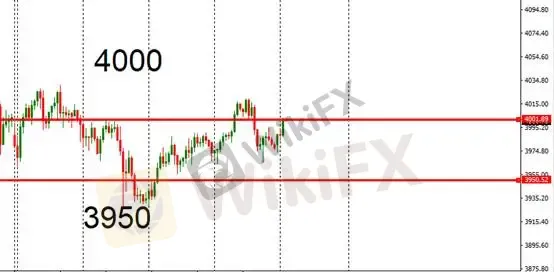简体中文
繁體中文
English
Pусский
日本語
ภาษาไทย
Tiếng Việt
Bahasa Indonesia
Español
हिन्दी
Filippiiniläinen
Français
Deutsch
Português
Türkçe
한국어
العربية
Federal Reserve’s December Rate Path Remains Unclear as Inflation Fears Loom Over 2025
Abstract:The Federal Reserve‘s potential rate cut in December has become increasingly uncertain. This year’s voting member, Austan Goolsbee, noted that the government shutdown has caused a disruption in key in
The Federal Reserve‘s potential rate cut in December has become increasingly uncertain. This year’s voting member, Austan Goolsbee, noted that the government shutdown has caused a disruption in key inflation data, making policy decisions more difficult. While labor market data can still be obtained through private sources, inflation indicators are almost entirely dependent on official reports. As a result, policymakers have been forced to rely on market and corporate feedback as alternative references. Incoming 2025 voting member Adriana Kugler emphasized that inflation remains a more pressing economic risk than employment. In the absence of reliable data, she has focused more on “price pressure signals” from businesses, suggesting a more hawkish stance. Meanwhile, Fed Governor Michael Barr reiterated that labor market stability remains a crucial foundation for monetary policy. New York Fed President John Williams, often referred to as the Feds “third-in-command,” added that the U.S. is still in a low neutral rate environment, and that real-time economic data provides stronger policy guidance than long-term rate estimates. Overall, internal disagreements within the Fed persist regarding the balance between inflation and employment, cooling market expectations for another rate cut in December.
At the same time, U.S. corporations are facing a new wave of layoffs under the “AI revolution.” According to the latest Challenger report, companies announced 153,074 job cuts in October—up 175.3% year-on-year and marking the highest October total in two decades. Year-to-date layoffs have now surpassed one million, the highest since the pandemic. Notably, corporate hiring plans have fallen to their lowest level since 2011, signaling cautious sentiment toward the economic outlook. Although AI-driven automation and efficiency gains have boosted productivity, they are also reshaping the labor market by accelerating job displacement across industries.
The retail sector is also showing weakness in employment. The National Retail Federation (NRF) projects that holiday-season hiring will total between 265,000 and 365,000 workers—the lowest in at least 15 years and well below last years 442,000 seasonal hires. This indicates that companies are being more cautious in balancing cost control and operational flexibility. However, on the consumer side, the NRF expects holiday spending from November to December to reach $1.1–$1.2 trillion, surpassing the trillion-dollar mark for the first time. This resilience in spending is partly supported by high-income households and credit-driven delayed consumption.
Overall, the Fed finds itself caught between “data gaps” and “inflation worries,” resulting in mixed monetary signals. Meanwhile, the surge in layoffs and the decline in hiring intentions suggest growing downside risks for the U.S. economy. In the short term, if the government shutdown continues to distort key data, the Fed may be forced to delay any policy action. However, if inflation proves stubborn, hawkish voices could once again dominate decision-making. The structural shifts brought about by AI and the illusion of consumer strength leave the U.S. economy in a delicate state of “coexisting heat and chill.” The coming months of economic data and policy direction will directly determine whether market confidence can stabilize and recover.
Gold Technical Analysis

Gold prices are currently hovering near the upper end of their range around $4,000/oz, with potential for another breakout. Traders can watch the $4,000 level closely—if it breaks upward, a short-term long position may be considered; otherwise, a small short position could be viable. Stop-loss levels should be set within $10–$20 above or below entry.
Resistance: $4,000/oz
Support: $3,950/oz
Risk Disclaimer:
The above views, analyses, research, prices, and other data are for general market commentary only and do not represent the stance of this platform. All visitors must assume full responsibility for their trading decisions. Please trade with caution.
Disclaimer:
The views in this article only represent the author's personal views, and do not constitute investment advice on this platform. This platform does not guarantee the accuracy, completeness and timeliness of the information in the article, and will not be liable for any loss caused by the use of or reliance on the information in the article.
WikiFX Broker
Latest News
Stonefort Securities Review: A Fair Look at Safety, Rules, and What Traders Say
Trump asks for meat packer probe over beef prices
Voices of the Golden Insight Award Jury | Tim Waterer, Chief Market Analyst of KCM Trade
Prop Firm Scams: When ‘Getting Funded’ Costs You Everything
PINAKINE Broker Review: A Complete Look at Its Services and Risks
One-Click Access to Broker Official Group Chats & Exclusive VPS Benefits
Easy Money Doesn't Exist! High-Return Promise Turned into an RM44,000 Scam
FXGlory Review: Vanishing Profits, Capital Scams & Withdrawal Charges Keep Annoying Traders
Charles Schwab Review: Traders Claim Illegitimate Profit Cancellation, Trade Manipulation & More
Is EclipseTrading.com a Legit Broker or a Scam?
Currency Calculator




